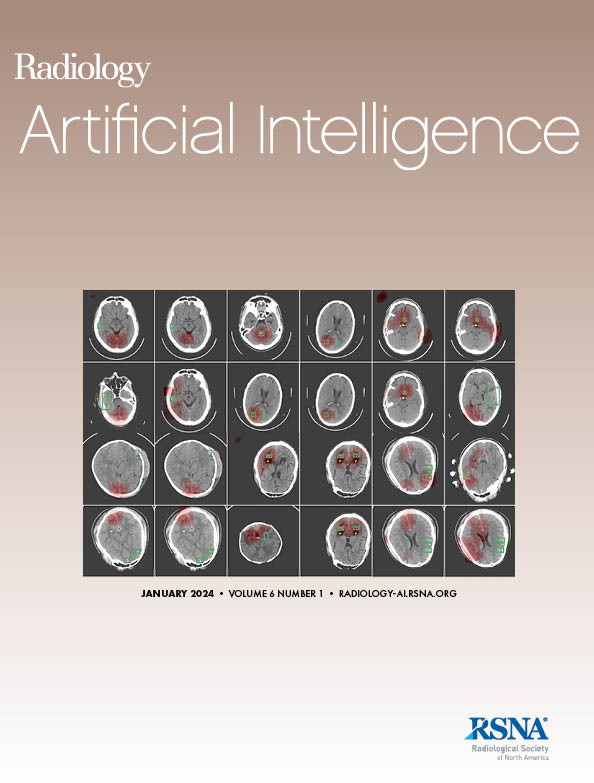Jong Hyuk Lee, Seung Ho Choi, Hugo J W L Aerts, Jakob Weiss, Vineet K Raghu, Michael T Lu, Jayoun Kim, Seungho Lee, Dongheon Lee, Hyungjin Kim
求助PDF
{"title":"在亚洲健康筛查人群胸片上使用开源AI预测呼吸系统疾病死亡风险","authors":"Jong Hyuk Lee, Seung Ho Choi, Hugo J W L Aerts, Jakob Weiss, Vineet K Raghu, Michael T Lu, Jayoun Kim, Seungho Lee, Dongheon Lee, Hyungjin Kim","doi":"10.1148/ryai.240628","DOIUrl":null,"url":null,"abstract":"<p><p>Purpose To assess the prognostic value of an open-source deep learning-based chest radiographs algorithm, CXR-Lung-Risk, for stratifying respiratory disease mortality risk among an Asian health screening population using baseline and follow-up chest radiographs. Materials and Methods This single-center, retrospective study analyzed chest radiographs from individuals who underwent health screenings between January 2004 and June 2018. The CXR-Lung-Risk scores from baseline chest radiographs were externally tested for predicting mortality due to lung disease or lung cancer, using competing risk analysis, with adjustments made for clinical factors. The additional value of these risk scores beyond clinical factors was evaluated using the likelihood ratio test. An exploratory analysis was conducted on the CXR-Lung-Risk trajectory over a 3-year follow-up period for individuals in the highest quartile of baseline respiratory disease mortality risk, using a time-series clustering algorithm. Results Among 36 924 individuals (median age, 58 years [IQR, 53-62 years]; 22 352 male), 264 individuals (0.7%) died of respiratory illness, over a median follow-up period of 11.0 years (IQR, 7.8-12.7 years). CXR-Lung-Risk predicted respiratory disease mortality (adjusted hazard ratio [HR] per 5 years: 2.01; 95% CI: 1.76, 2.39; <i>P</i> < .001), offering a prognostic improvement over clinical factors (<i>P</i> < .001). The trajectory analysis identified a subgroup with a continuous increase in CXR-Lung-Risk score, which was associated with poorer outcomes (adjusted HR for respiratory disease mortality: 3.26; 95% CI: 1.20, 8.81; <i>P</i> = .02) compared with the subgroup with a continuous decrease in CXR-Lung-Risk score. Conclusion The open-source CXR-Lung-Risk model predicted respiratory disease mortality in an Asian cohort, enabling a two-layer risk stratification approach through an exploratory longitudinal analysis of baseline and follow-up chest radiographs. <b>Keywords:</b> Conventional Radiography, Thorax, Lung, Mediastinum, Heart, Outcomes Analysis <i>Supplemental material is available for this article.</i> © RSNA, 2025 See also commentary by Júdice de Mattos Farina and Kuriki in this issue.</p>","PeriodicalId":29787,"journal":{"name":"Radiology-Artificial Intelligence","volume":" ","pages":"e240628"},"PeriodicalIF":13.2000,"publicationDate":"2025-05-01","publicationTypes":"Journal Article","fieldsOfStudy":null,"isOpenAccess":false,"openAccessPdf":"","citationCount":"0","resultStr":"{\"title\":\"Predicting Respiratory Disease Mortality Risk Using Open-Source AI on Chest Radiographs in an Asian Health Screening Population.\",\"authors\":\"Jong Hyuk Lee, Seung Ho Choi, Hugo J W L Aerts, Jakob Weiss, Vineet K Raghu, Michael T Lu, Jayoun Kim, Seungho Lee, Dongheon Lee, Hyungjin Kim\",\"doi\":\"10.1148/ryai.240628\",\"DOIUrl\":null,\"url\":null,\"abstract\":\"<p><p>Purpose To assess the prognostic value of an open-source deep learning-based chest radiographs algorithm, CXR-Lung-Risk, for stratifying respiratory disease mortality risk among an Asian health screening population using baseline and follow-up chest radiographs. Materials and Methods This single-center, retrospective study analyzed chest radiographs from individuals who underwent health screenings between January 2004 and June 2018. The CXR-Lung-Risk scores from baseline chest radiographs were externally tested for predicting mortality due to lung disease or lung cancer, using competing risk analysis, with adjustments made for clinical factors. The additional value of these risk scores beyond clinical factors was evaluated using the likelihood ratio test. An exploratory analysis was conducted on the CXR-Lung-Risk trajectory over a 3-year follow-up period for individuals in the highest quartile of baseline respiratory disease mortality risk, using a time-series clustering algorithm. Results Among 36 924 individuals (median age, 58 years [IQR, 53-62 years]; 22 352 male), 264 individuals (0.7%) died of respiratory illness, over a median follow-up period of 11.0 years (IQR, 7.8-12.7 years). CXR-Lung-Risk predicted respiratory disease mortality (adjusted hazard ratio [HR] per 5 years: 2.01; 95% CI: 1.76, 2.39; <i>P</i> < .001), offering a prognostic improvement over clinical factors (<i>P</i> < .001). The trajectory analysis identified a subgroup with a continuous increase in CXR-Lung-Risk score, which was associated with poorer outcomes (adjusted HR for respiratory disease mortality: 3.26; 95% CI: 1.20, 8.81; <i>P</i> = .02) compared with the subgroup with a continuous decrease in CXR-Lung-Risk score. Conclusion The open-source CXR-Lung-Risk model predicted respiratory disease mortality in an Asian cohort, enabling a two-layer risk stratification approach through an exploratory longitudinal analysis of baseline and follow-up chest radiographs. <b>Keywords:</b> Conventional Radiography, Thorax, Lung, Mediastinum, Heart, Outcomes Analysis <i>Supplemental material is available for this article.</i> © RSNA, 2025 See also commentary by Júdice de Mattos Farina and Kuriki in this issue.</p>\",\"PeriodicalId\":29787,\"journal\":{\"name\":\"Radiology-Artificial Intelligence\",\"volume\":\" \",\"pages\":\"e240628\"},\"PeriodicalIF\":13.2000,\"publicationDate\":\"2025-05-01\",\"publicationTypes\":\"Journal Article\",\"fieldsOfStudy\":null,\"isOpenAccess\":false,\"openAccessPdf\":\"\",\"citationCount\":\"0\",\"resultStr\":null,\"platform\":\"Semanticscholar\",\"paperid\":null,\"PeriodicalName\":\"Radiology-Artificial Intelligence\",\"FirstCategoryId\":\"1085\",\"ListUrlMain\":\"https://doi.org/10.1148/ryai.240628\",\"RegionNum\":0,\"RegionCategory\":null,\"ArticlePicture\":[],\"TitleCN\":null,\"AbstractTextCN\":null,\"PMCID\":null,\"EPubDate\":\"\",\"PubModel\":\"\",\"JCR\":\"Q1\",\"JCRName\":\"COMPUTER SCIENCE, ARTIFICIAL INTELLIGENCE\",\"Score\":null,\"Total\":0}","platform":"Semanticscholar","paperid":null,"PeriodicalName":"Radiology-Artificial Intelligence","FirstCategoryId":"1085","ListUrlMain":"https://doi.org/10.1148/ryai.240628","RegionNum":0,"RegionCategory":null,"ArticlePicture":[],"TitleCN":null,"AbstractTextCN":null,"PMCID":null,"EPubDate":"","PubModel":"","JCR":"Q1","JCRName":"COMPUTER SCIENCE, ARTIFICIAL INTELLIGENCE","Score":null,"Total":0}
引用次数: 0
引用
批量引用

 求助内容:
求助内容: 应助结果提醒方式:
应助结果提醒方式:


